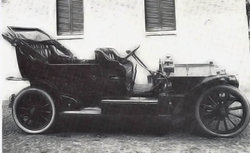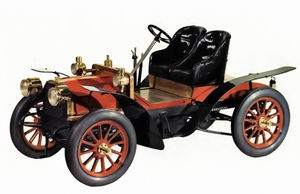Fiat 24-32 HP

| |
| Fiat 24-32 HP | |
|---|---|
| Assembly | |
| Manufacturer | Fiat |
| Production | 1903-1905 around 400 produced |
| Class | Luxury car |
| Layout | FR layout |
| Body style | |
| Engine | 6371 cc straight-4 6902 cc straight-4 7363 cc straight-4 |
| Transmission | 4-speed manual |
| Length | 4000mm-4380mm |
| Width | 1430mm |
| Height | 2350mm |
| Weight | 1700kg |
| Wheelbase | |
| Predecessor | Fiat 12 HP |
| Successor | Fiat 16-20 HP |
| Related | |
| Designer | |
The Fiat Fiat 24-32 HP was introduced by the Italian manufacturer Fiat in 1903. The car was designed to allow coachbuilders to make bodies for it, it was offered with 3 different wheelbases, short, medium and long.
It was equipped with 4-cylinder engine:
- 1st series with a 6371 cc engine - 32 hp
- 2nd series in 1904 with a 6902 cc engine - 32 hp
- 3rd series in 1905 with a 7363 cc engine - 32 hp
There were more than 400 copies made in the plant Corso Dante in Turin.
This featured some important technological innovations: it was first sedan car to use a "Landaulet" body type, fisrt car to have gas pedal and a gearbox with 4 forward gears. The road model could achieve top speed of 75km/h.
In 1902 Fiat introduced racing version the 24 HP 1902 Corsa. This car was the first car in history to be a real race car, specially designed for that purpose and not derived from a series production automobile. . The Corsa had a full steel chassis rather than wood that dominated at the time, a twin-engine block 7238 cc developing 40 hp. Weighing in at just 450kg, it exceeded the speed of 100km/h, which was very high speed of those days. This car dominated all of its competitors since its first release in competition. The car won the race côte-Superga Sassi, near Turin on June 29, 1902 and July 27, with Vincenzo Lancia driving, the race Susa - Col du Mont-Cenis at the average speed of 44.16km/h.
24/32hp, 6,908 cc. T-head four-cylinder engine
- four-speed manual transmission
- solid front axle with semi-elliptic leaf springs, solid rear axle with semi-elliptic leaf springs
- double chain drive
- two-wheel mechanical brakes with mechanical driveline brake
- Wheelbase: 117-3/8"
On the first of July, 1899, four young Italian gentlemen met in Turin: Emanuele Cacherano di Bricherasio, Giovanni Agnelli, Cesare Goria-Gatti and Roberto Biscaretti di Ruffia. Keen horsemen, they were also interested in the emerging motor industry. Before they parted, they had drawn up the articles of association for Fabbrica Italiana Automobili Torino (Italian Automobile Factory of Torino). In the Italian penchant for acronyms, it became F.I.A.T., after 1906 “FIAT”, and, today, usually simply “Fiat.”
To start, the new F.I.A.T. absorbed a bicycle company owned by Giovanni Ceirano, who had built a prototype car called the Welleyes, and acquired Ceirano’s patents. Aristide Faccioli, designer of the Welleyes, was appointed technical director. The first Fiat car, propelled by a 3-1/2 horsepower horizontal twin, was derived from that prototype. By 1901, Fiat was producing 80 cars, with a front-mounted 8-hp vertical twin; the first four-cylinder car, the 12/16, appeared later in the year, replaced by a larger 16/20 hp, 4,181 cc model in 1903. This was a T-head design (earlier cars had atmospheric intake valves), with low tension magneto ignition, pump-circulated water cooling, a four-speed selective transmission and dual chain drive. This would be the pattern for Fiats over the next three years. Production in 1903 was 135 cars, but profitability was yet to come, as losses in 1900 and 1901 had been followed by two break-even years.
For 1904, Fiat made a dramatic change from steel-reinforced wood chassis to pressed steel frames. The 16/20 hp model was exported to America, where Hollander & Tengeman of New York, sole agents for the U.S. and Canada, sold most of the 200-car output for prices of $6,700 and up. “Find It All There” read their advertising, in a play on the acronym, “and use your hands for steering only,” referring to the clutch, brake and accelerator located in close proximity on the floor.Source
| Fiat car timeline, European market, 1899s-1949s Next -> | ||||||||||||||||||||||||||||||||||||||||||||||||||||
|---|---|---|---|---|---|---|---|---|---|---|---|---|---|---|---|---|---|---|---|---|---|---|---|---|---|---|---|---|---|---|---|---|---|---|---|---|---|---|---|---|---|---|---|---|---|---|---|---|---|---|---|---|
| Type | 1890s | 1900s | 1910s | 1920s | 1930s | 1940s | ||||||||||||||||||||||||||||||||||||||||||||||
| 8 | 9 | 0 | 1 | 2 | 3 | 4 | 5 | 6 | 7 | 8 | 9 | 0 | 1 | 2 | 3 | 4 | 5 | 6 | 7 | 8 | 9 | 0 | 1 | 2 | 3 | 4 | 5 | 6 | 7 | 8 | 9 | 0 | 1 | 2 | 3 | 4 | 5 | 6 | 7 | 8 | 9 | 0 | 1 | 2 | 3 | 4 | 5 | 6 | 7 | 8 | 9 | |
| City car | 3,5 HP | 500 A / 500 B (Topolino) ... | ||||||||||||||||||||||||||||||||||||||||||||||||||
| Small family car | 6 HP 8 HP 10 HP |
509 / 509 S | 508 (Ballila) | Ballila 1100 A / B ... | ||||||||||||||||||||||||||||||||||||||||||||||||
| Family car | 1 | 1A / Zero | 70 | 501 / 501 S / 502 / 503 | 514 / 515 | 1500 | ||||||||||||||||||||||||||||||||||||||||||||||
| Large family car | Brevetti | 2 | 2B | 505 | 507 | 518 | ||||||||||||||||||||||||||||||||||||||||||||||
| 12 HP / 16-20 HP / 16-24 HP | 15-25 HP Brevetti | 520 / 521 | 522 / 524 | 527 | 2800 | |||||||||||||||||||||||||||||||||||||||||||||||
| Executive car | 20-30 HP | 3 | 3A / 3Ter | 510 | 512 | 525 / 525 S | ||||||||||||||||||||||||||||||||||||||||||||||
| 24-32 HP / 60 HP | 28-40 HP / 30-45 HP / 50 HP | 4 / 5 / 6 | 520 "Superfiat" | 519 / 519 S | ||||||||||||||||||||||||||||||||||||||||||||||||
| Race car | ||||||||||||||||||||||||||||||||||||||||||||||||||||
| 130 HP Corsa | ||||||||||||||||||||||||||||||||||||||||||||||||||||
